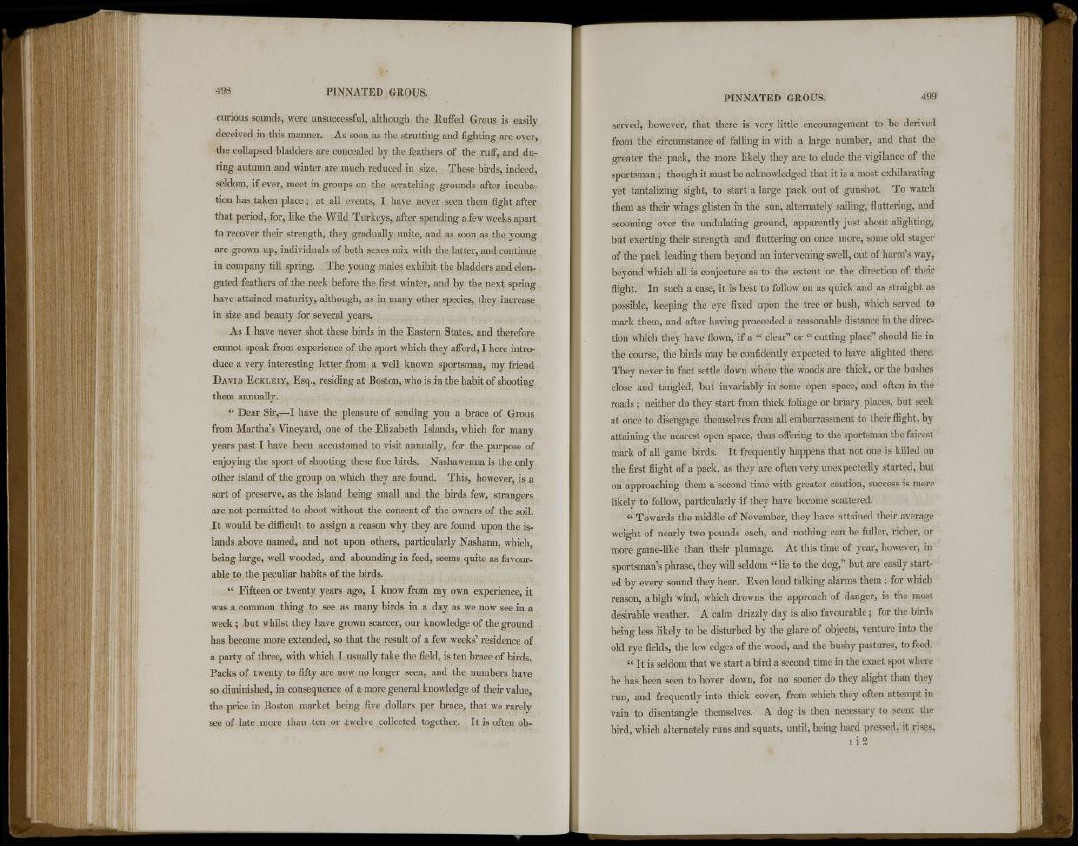
curious sounds, were unsuccessful, although the Ruffed Grous is easily
deceived in this manner. As soon as the strutting and fighting are over,
the collapsed bladders are concealed by the feathers of the ruff, and during
autumn and winter are much reduced in size. These birds, indeed,
seldom, if ever, meet in groups on the scratching grounds after incubation
has taken place; at all events, I have never seen them fight after
that period, for, like the Wild Turkeys, after spending a few weeks apart
to recover their strength, they gradually unite, and as soon as the young
are grown up, individuals of both sexes mix with the latter, and continue
in company till spring. The young males exhibit the bladders and elongated
feathers of the neck before the first winter, and by the next spring
have attained maturity, although, as in many other species, they increase
in size and beauty for several years.
As I have never shot these birds in the Eastern States, and therefore
cannot speak from experience of the sport which they afford, I here introduce
a very interesting letter from a well known sportsman, my friend
DAVID ECKLEIY, Esq., residing at Boston, who is in the habit of shooting
them annually.
" Dear Sir,—I have the pleasure of sending you a brace of Grous
from Martha's Vineyard, one of the Elizabeth Islands, which for many
years past I have been accustomed to visit annually, for the purpose of
enjoying the sport of shooting these fine birds. Nashawenna is the only
other island of the group on which they are found. This, however, is a
sort of preserve, as the island being small and the birds few, strangers
are not permitted to shoot without the consent of the owners of the soil.
It would be difficult to assign a reason why they are found upon the islands
above named, and not upon others, particularly Nashann, which,
being large, well wooded, and abounding in feed, seems quite as favourable
to the peculiar habits of the birds.
" Fifteen or twenty years ago, I know from my own experience, it
was a common thing to see as many birds in a day as we now see in a
week ; but whilst they have grown scarcer, our knowledge of the ground
has become more extended, so that the result of a few weeks' residence of
a party of three, with which I usually take the field, is ten brace of birds.
Packs of twenty to fifty are now no longer seen, and the numbers have
so diminished, in consequence of a more general knowledge of their value,
the price in Boston market being five dollars per brace, that we rarely
see of late more than ten or twelve collected together. It is often observed,
however, that there is very little encouragement to be derived
from the circumstance of falling in with a large number, and that the
greater the pack, the more likely they are to elude the vigilance of the
sportsman ; though it must be acknowledged that it is a most exhilarating
yet tantalizing sight, to start a large pack out of gunshot. To watch
them as their wings glisten in the sun, alternately sailing, fluttering, and
scooming over the undulating ground, apparently just about alighting,
but exerting their strength and fluttering on once more, some old stager
of the pack leading them beyond an intervening swell, out of harm's way,
beyond which all is conjecture as to the extent or the direction of their
flight. In such a case, it is best to follow on as quick and as straight as
possible, keeping the eye fixed upon the tree or bush, which served to
mark them, and after having proceeded a reasonable distance in the direction
which they have flown, if a " clear" or " cutting place" should lie in
the course, the birds may be confidently expected to have alighted there.
They never in fact settle down where the woods are thick, or the bushes
close and tangled, but invariably in some open space, and often in the
roads; neither do they start from thick foliage or briary places, but seek
at once to disengage themselves from all embarrassment to their flight, by
attaining the nearest open space, thus offering to the sportsman the fairest
mark of all game birds. It frequently happens that not one is killed on
the first flight of a pack, as they are often very unexpectedly started, but
on approaching them a second time with greater caution, success is more
likely to follow, particularly if they have become scattered.
" Towards the middle of November, they have attained their average
weight of nearly two pounds each, and nothing can be fuller, richer, or
more game-like than their plumage. At this time of year, however, in
sportsman's phrase, they will seldom " lie to the dog," but are easily started
by every sound they hear. Even loud talking alarms them ; for which
reason, a high wind, which drowns the approach of danger, is the most
desirable weather. A calm drizzly day is also favourable; for the birds
being less likely to be disturbed by the glare of objects, venture into the
old rye fields, the low edges of the wood, and the bushy pastures, to feed.
" It is seldom that we start a bird a second time in the exact spot where
he has been seen to hover down, for no sooner do they alight than they
run, and frequently into thick cover, from which they often attempt in
vain to disentangle themselves. A dog is then necessary to scent the
bird, which alternately runs and squats, until, being hard pressed, it rises,
i i 2